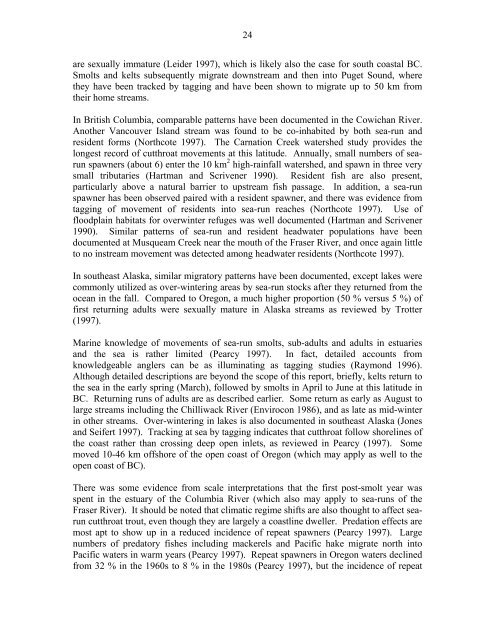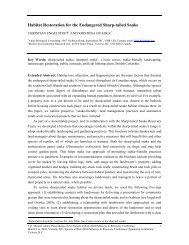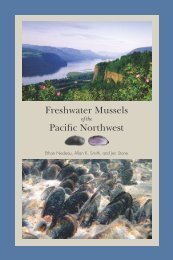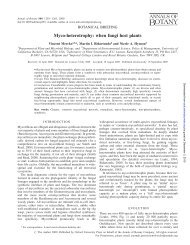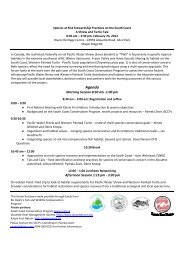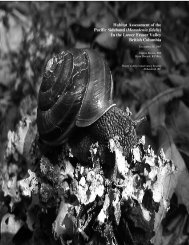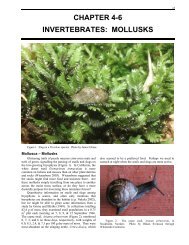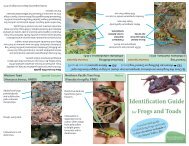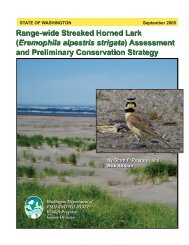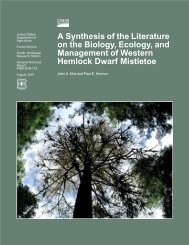Coastal Cutthroat Trout as Sentinels of Lower Mainland Watershed ...
Coastal Cutthroat Trout as Sentinels of Lower Mainland Watershed ...
Coastal Cutthroat Trout as Sentinels of Lower Mainland Watershed ...
You also want an ePaper? Increase the reach of your titles
YUMPU automatically turns print PDFs into web optimized ePapers that Google loves.
24are sexually immature (Leider 1997), which is likely also the c<strong>as</strong>e for south co<strong>as</strong>tal BC.Smolts and kelts subsequently migrate downstream and then into Puget Sound, wherethey have been tracked by tagging and have been shown to migrate up to 50 km fromtheir home streams.In British Columbia, comparable patterns have been documented in the Cowichan River.Another Vancouver Island stream w<strong>as</strong> found to be co-inhabited by both sea-run andresident forms (Northcote 1997). The Carnation Creek watershed study provides thelongest record <strong>of</strong> cutthroat movements at this latitude. Annually, small numbers <strong>of</strong> searunspawners (about 6) enter the 10 km 2 high-rainfall watershed, and spawn in three verysmall tributaries (Hartman and Scrivener 1990). Resident fish are also present,particularly above a natural barrier to upstream fish p<strong>as</strong>sage. In addition, a sea-runspawner h<strong>as</strong> been observed paired with a resident spawner, and there w<strong>as</strong> evidence fromtagging <strong>of</strong> movement <strong>of</strong> residents into sea-run reaches (Northcote 1997). Use <strong>of</strong>floodplain habitats for overwinter refuges w<strong>as</strong> well documented (Hartman and Scrivener1990). Similar patterns <strong>of</strong> sea-run and resident headwater populations have beendocumented at Musqueam Creek near the mouth <strong>of</strong> the Fr<strong>as</strong>er River, and once again littleto no instream movement w<strong>as</strong> detected among headwater residents (Northcote 1997).In southe<strong>as</strong>t Al<strong>as</strong>ka, similar migratory patterns have been documented, except lakes werecommonly utilized <strong>as</strong> over-wintering are<strong>as</strong> by sea-run stocks after they returned from theocean in the fall. Compared to Oregon, a much higher proportion (50 % versus 5 %) <strong>of</strong>first returning adults were sexually mature in Al<strong>as</strong>ka streams <strong>as</strong> reviewed by Trotter(1997).Marine knowledge <strong>of</strong> movements <strong>of</strong> sea-run smolts, sub-adults and adults in estuariesand the sea is rather limited (Pearcy 1997). In fact, detailed accounts fromknowledgeable anglers can be <strong>as</strong> illuminating <strong>as</strong> tagging studies (Raymond 1996).Although detailed descriptions are beyond the scope <strong>of</strong> this report, briefly, kelts return tothe sea in the early spring (March), followed by smolts in April to June at this latitude inBC. Returning runs <strong>of</strong> adults are <strong>as</strong> described earlier. Some return <strong>as</strong> early <strong>as</strong> August tolarge streams including the Chilliwack River (Envirocon 1986), and <strong>as</strong> late <strong>as</strong> mid-winterin other streams. Over-wintering in lakes is also documented in southe<strong>as</strong>t Al<strong>as</strong>ka (Jonesand Seifert 1997). Tracking at sea by tagging indicates that cutthroat follow shorelines <strong>of</strong>the co<strong>as</strong>t rather than crossing deep open inlets, <strong>as</strong> reviewed in Pearcy (1997). Somemoved 10-46 km <strong>of</strong>fshore <strong>of</strong> the open co<strong>as</strong>t <strong>of</strong> Oregon (which may apply <strong>as</strong> well to theopen co<strong>as</strong>t <strong>of</strong> BC).There w<strong>as</strong> some evidence from scale interpretations that the first post-smolt year w<strong>as</strong>spent in the estuary <strong>of</strong> the Columbia River (which also may apply to sea-runs <strong>of</strong> theFr<strong>as</strong>er River). It should be noted that climatic regime shifts are also thought to affect searuncutthroat trout, even though they are largely a co<strong>as</strong>tline dweller. Predation effects aremost apt to show up in a reduced incidence <strong>of</strong> repeat spawners (Pearcy 1997). Largenumbers <strong>of</strong> predatory fishes including mackerels and Pacific hake migrate north intoPacific waters in warm years (Pearcy 1997). Repeat spawners in Oregon waters declinedfrom 32 % in the 1960s to 8 % in the 1980s (Pearcy 1997), but the incidence <strong>of</strong> repeat


